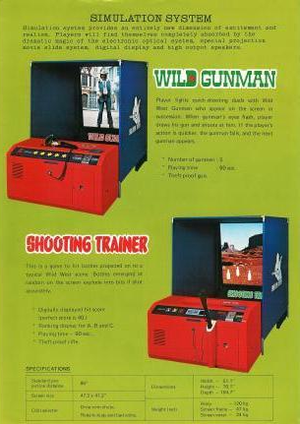Simulation System

| |
| Simulation System | |
| Designer | Nintendo R&D1 |
|---|---|
| Manufacturer | Nintendo |
| CPU | discrete circuitry |
| Graphics | |
| Memory | |
| Media | 16mm film |
| Released | JP: 1973 - 1978 |
| Added to Museum | Not yet |
The Simulation System was an arcade game system by Nintendo. It utilized a light gun, which shot at objects projected via a 16mm film projector.
Early development
In 1970, Nintendo began releasing their Beam Gun series of toys, utilizing a light gun designed by Masayuki Uemura, in which the light gun fired at physical targets. Then, in 1971, Nintendo president Hiroshi Yamauchi wanted to expand their lightgun toys into a shooting range simulation. He asked Gunpei Yokoi, who had created several successful toys for Nintendo, to create a simulation based on clay pigeon shooting.
Hiroshi Yamauchi intended for these shooting range simulations to be installed in vacant bowling alleys. After Americans brought bowling to Japan after they continued to live there after World War II, bowling became a popular Japanese pastime. The Japanese bowling fad was short-lived however, as by the 1970s, many bowling alleys were sitting abandoned. Nintendo purchased several of these bowling alleys with the intention to convert them into electronic shooting ranges. Gunpei Yokoi and Masayuki Uemura, together with Genyo Takeda, worked under the newly formed Nintendo Research & Development 1 division of Nintendo, and created a shooting gallery game to use in Nintendo's converted bowling alleys.
The result was the Laser Clay Shooting System, which consisted of a screen, with a film of clay pigeons broadcast on it over an overhead projector. In front was the lightgun, which when fired, a network of reflective surfaces would register whether the shot was a hit or a miss. The game was unveiled in 1973, however its first demonstration didn't work properly. Yokoi had to stand behind the screen, adding the score to the system manually. After its unveiling, the bug in the program was fixed, and the game worked perfectly for the rest of the time it was in operation.
The Simulation System
After the 1973 Oil Crisis, Nintendo had to abandon its grand plans to use Japan's bowling alleys as electronic shooting ranges. They reduced the size of the system so that it could be sold as an arcade game. The Laser Clay Shooting System was adapted for the smaller setup and was sold to arcades as Mini Laser Clay. Sales for Nintendo's Simulation System started off slowly, but they gradually increased in volume, which led to Nintendo adapting the system for use with other 16-mm films. The additional games were Wild Gunman in 1974, Shooting Trainer and Sky Hawk in 1976, and Battle Shark in 1977, and lastly in 1978, Test Driver.
There was also an arcade game produced using EVR film on a cathode ray tube display, titled EVR Race, a game where up to six players would watch a film of horses or cars winning and bet on which one would be the winner, which was released in 1975. Another variant was EVR Baseball where players would bet on the winner of a baseball game being played on the film.
Legacy
In 1976, the Simulation System was adapted into their Beam Gun SP series of games with Duck Hunt. This light gun game used a projector and was intended for home use.
On July 15, 1983, Nintendo began selling their Family Computer console, and they soon developed light gun games for use with it. When the Beam Gun, named after Nintendo's successful light gun toy line, was released on February 18, 1984, an adaptation of Wild Gunman was released alongside it. The Famicom Beam Gun resembled a revolver, which fit in with the Old West theme of Wild Gunman. Another adaptation of a projector-based light gun game, Duck Hunt, was released on April 21, 1984. The alternate mode in the NES version of Duck Hunt was an adaptation of Laser Clay Shooting System.
Simulation System games
| Title | Developer | Release | Added to museum | Notes |
|---|---|---|---|---|
| Battle Shark | Nintendo R&D1 | 1977 | ||
| Laser Clay Shooting System | Nintendo R&D1 | 1973 | First version was equipped in a converted bowling alley. Its size was decreased for use in the arcade. This version was titled Mini Laser Clay. | |
| Shooting Trainer | Nintendo R&D1 | 1976 | ||
| Sky Hawk | Nintendo R&D1 | 1976 | ||
| Test Driver | Nintendo R&D1 | 1978 | ||
| Wild Gunman | Nintendo R&D1 | 1974 | A sprite-based remake for the Nintendo Entertainment System released in 1984. |